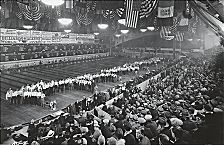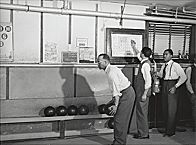| Entries |
| B |
|
Bowling
|

|
In January 1901 Chicago received endorsement as one of the nation's leading bowling centers when the American Bowling Congress (ABC) conducted its inaugural national men's tournament on the lanes in the Welsbach Building on Wabash Avenue in the Loop. Chicago subsequently hosted five other ABC tournaments. That same weekend the Chicago Women's Bowling Association sponsored a tournament which it billed as the first United States women's championships. While this tourney was short-lived, Chicago would play host to Women's International Bowling Congress tournaments in 1920 and 1935.
In 1911 the top men bowlers of Chicago organized the now-legendary Randolph League, a prestigious circuit that operated until 1946. Another circuit for the city's top-flight men bowlers, organized in the early years of the twentieth century, was the Classic League, the spirit of which continues in the city's various major leagues.

|
In 1927 the Chicago Herald-Examiner inaugurated the Weekly High Game Bowling Contest, a tournament for men and women league bowlers. The event soon became an annual women's team handicap tournament, known as the Herald-American Women's Bowling Classic from the 1950s until its demise in the mid-1960s. In 1961 the Chicago Sun-Times joined with the Bowling Proprietors' Association to cosponsor an annual handicap tournament for individual men and women bowlers, called Beat the Champions, which remained in operation at the end of the century.
Another major Chicago bowling event, the All-Star Tournament, began in 1941 under the cosponsorship of the Bowling Proprietors of America and Chicago Tribune Charities. This grueling marathon tournament, usually held at the Chicago Coliseum, determined the national individual match game championship. A women's division was added in 1949, before the annual competition was moved out of Chicago in 1957.
Television provided a major stimulus to the sport's increasing popularity in the 1950s. In 1952, WMAQ -TV launched Championship Bowling, a weekly one-hour show featuring taped matches between professional bowlers. For many years the shows were filmed at the Faetz-Niesen Lanes and were announced by sportscaster “Whispering” Joe Wilson. In the mid-1950s, WBKB-TV carried Universal Bowling Clinic, a weekly half-hour program featuring bowling news and lessons and cohosted by Sam Weinstein and hall-of-fame bowler Paul Krumske. Long after local bowling shows had disappeared from Chicago television, Weinstein, known as the Tenpin Tattler, carried on with a weekly radio program about bowling until the 1990s.
The Encyclopedia of Chicago © 2004 The Newberry Library. All Rights Reserved. Portions are copyrighted by other institutions and individuals. Additional information on copyright and permissions.